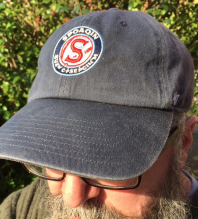 I was helping move some shelves in the sports section not long ago when a little piece of history fluttered out from a crevice.
I was helping move some shelves in the sports section not long ago when a little piece of history fluttered out from a crevice.
In case it’s not clear from the photo, that’s a 56-year-old box seat ticket that let some lucky fan watch the Portland Beavers play in what was then known as Multnomah Stadium. Now, Island Books is old, but it wasn’t around in 1960. I checked with our former owner, who confirmed that the store wasn’t built on the ruins of a sports museum. Instead, the ticket turned up between the pages of a secondhand book a couple of decades ago and spent a few years tacked to the wall before disappearing again as mysteriously as it had arrived. My fellow shelf-shifter found a frame for it, so hopefully we can take better care of our rediscovery going forward.
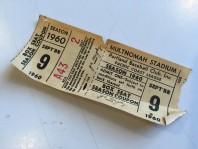 This is the perfect time to put it back on display, since we’re about to celebrate the most important spring holiday of all: Opening Day, when the new major league season begins. Yes, baseball, like the sun, always returns to the upper left corner of the country. Eventually.
This is the perfect time to put it back on display, since we’re about to celebrate the most important spring holiday of all: Opening Day, when the new major league season begins. Yes, baseball, like the sun, always returns to the upper left corner of the country. Eventually.
Nowhere in our region is without it, as Mark Armour, editor of Rain Check: Baseball in the Pacific Northwest, can tell you. Even the northest and westest portion, Alaska, has a strong baseball tradition. For over a century Fairbanks has hosted an annual Midnight Sun Game, for example. Anchorage native Curt Schilling is now a professional blowhard, but before that he was a pinpoint control artist on the mound and is still a should-be Hall of Famer. His erstwhile teammate and fellow World Series champion Randy Johnson was briefly a Glacier Pilot in the Alaska League. A near-seven-foot southpaw throwing 90-mile-an-hour heat above the Arctic Circle was undoubtedly an unusual sight, but Anchorage’s Mulcahy Stadium has seen far odder things than that.
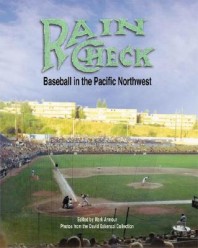 Idaho too has generated baseball legends. All-time great righthander Walter Johnson made his reputation on the sandlots of Weiser, and a kid from Payette who played on a field named after him grew up to be one of the greatest home run hitters ever: Harmon Killebrew. The press called him “Killer” for his power, but he never took to the name, which didn’t fit his gentle character at all. This was a man who, asked in an interview what hobbies he had, replied, “Just washing the dishes, I guess.”
Idaho too has generated baseball legends. All-time great righthander Walter Johnson made his reputation on the sandlots of Weiser, and a kid from Payette who played on a field named after him grew up to be one of the greatest home run hitters ever: Harmon Killebrew. The press called him “Killer” for his power, but he never took to the name, which didn’t fit his gentle character at all. This was a man who, asked in an interview what hobbies he had, replied, “Just washing the dishes, I guess.”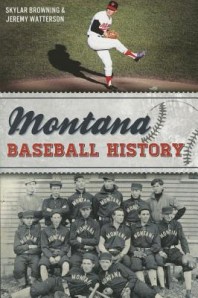
Idaho’s neighbor to the east hasn’t produced many big leaguers of note, but there’s still plenty of baseball in Montana and always has been. Authors Sklyar Browning and Jeremy Watterson tell the whole story in Montana Baseball History, including a mention of how the members of the Lewis and Clark expedition played a forerunner game called “prison base” along the trail.
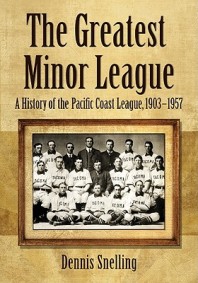 Crossing into Oregon lets us talk about the Pacific Coast League, which for decades was the biggest game around, referred to as a third major league. It declined only when the Giants and Dodgers moved west, and Its heyday is well chronicled for today’s readers. Dennis Snelling’s The Greatest Minor League is readily available, though Paul Zingg’s Runs, Hits, and an Era is sadly out of print. Oregon’s PCL representative was the above-mentioned Beavers, a team that’s visually documented in The Portland Beavers, part of Arcadia Publishing’s Images of Baseball series. Portland was also home to a short-lived Negro League squad called the Roses, owned by Olympic champion Jesse Owens, and later to a scruffy bunch of independent upstarts called the Mavericks. Imagine the Bad News Bears grown to adult size but still in possession of their Little League maturity level and you’ll get the idea. A documentary about them, “The Battered Bastards of Baseball,” is required viewing for anyone who loves underdogs and ’70s mustaches.
Crossing into Oregon lets us talk about the Pacific Coast League, which for decades was the biggest game around, referred to as a third major league. It declined only when the Giants and Dodgers moved west, and Its heyday is well chronicled for today’s readers. Dennis Snelling’s The Greatest Minor League is readily available, though Paul Zingg’s Runs, Hits, and an Era is sadly out of print. Oregon’s PCL representative was the above-mentioned Beavers, a team that’s visually documented in The Portland Beavers, part of Arcadia Publishing’s Images of Baseball series. Portland was also home to a short-lived Negro League squad called the Roses, owned by Olympic champion Jesse Owens, and later to a scruffy bunch of independent upstarts called the Mavericks. Imagine the Bad News Bears grown to adult size but still in possession of their Little League maturity level and you’ll get the idea. A documentary about them, “The Battered Bastards of Baseball,” is required viewing for anyone who loves underdogs and ’70s mustaches.
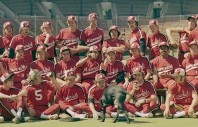
The Portland Mavericks– owned by Bing Russell, actor (& actor Kurt Russell’s dad)
Fording the Columbia brings us into Washington, where the cities that begin with an S have made particularly important contributions to the sport’s history. Snohomish gave us Hall of Fame outfielder Earl Averill and Spokane provided (and still does) a home for the minor-league Indians franchise. Unlike almost every other team that appropriates the iconography of indigenous peoples, the Spokane organization has worked closely with the local tribe to ensure that their team presents itself in a respectful way. This includes uniforms that identify the team in Salish characters, and a souvenir cap reading SPOAQIN SUxʷč+SEp̓CIN’M is the pride of my collection.
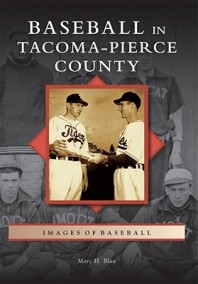 Multi-sport star Ernie Tanner hailed from Tacoma and was eulogized as “the greatest athlete ever developed in the Northwest.” Unfortunately for all of us, he lived during a time when the color of his skin kept him out of open competition, but he still left a record of excellence behind him on the field and off. Additional local imagery is on view in another volume from Arcadia, Baseball in Tacoma-Pierce County.
Multi-sport star Ernie Tanner hailed from Tacoma and was eulogized as “the greatest athlete ever developed in the Northwest.” Unfortunately for all of us, he lived during a time when the color of his skin kept him out of open competition, but he still left a record of excellence behind him on the field and off. Additional local imagery is on view in another volume from Arcadia, Baseball in Tacoma-Pierce County.

Seattle’s Nisei League Mikado squad
As an Emerald City resident, I may be biased, but I think Seattle has the richest NW baseball lore of all. Hall of Fame natives? Check–Ron Santo. Negro League representation? Yep–Seattle Steelheads. We’ve also fielded successful teams in the Japanese-American Nisei League, including the Mikado squad that won multiple titles and toured Japan after a devastating earthquake in 1923. Seattle was an integral part of the PCL, starting out with a team that called themselves the Purple Sox for a season and then chose a name that stuck, the Rainiers. That was the organization for which Fred Hutchinson first played professionally, jumping almost straight from a championship at Franklin High to a 25-win season for the Rainiers as a 19-year-old. Hutch went on to a long major league career as both player and manager before bequeathing his name to one of the foremost cancer research institutions in the world. His remarkable life is told in both a standard biography and as a graphic novel, and the Rainiers have their own comprehensive account in Pitchers of Beer by Dan Raley.
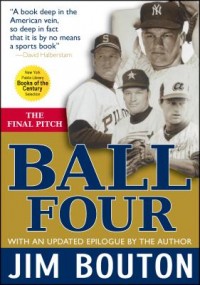 Not to pull rank, but Seattle is also the only big-league town in the region. The 1969 Seattle Pilots didn’t start things off on the right foot, lasting only a season before pulling up stakes and heading for Milwaukee, but they did give us one of the best baseball books ever written, the revealing and irreverent Ball Four by knuckleballer Jim Bouton. We had to wait almost a decade for our next opportunity (and even longer for our next winning season) but once the Seattle Mariners arrived, a love affair started that spread across the region. Thanks to the whole Northwest, the M’s have the geographically largest fan base in the majors.
Not to pull rank, but Seattle is also the only big-league town in the region. The 1969 Seattle Pilots didn’t start things off on the right foot, lasting only a season before pulling up stakes and heading for Milwaukee, but they did give us one of the best baseball books ever written, the revealing and irreverent Ball Four by knuckleballer Jim Bouton. We had to wait almost a decade for our next opportunity (and even longer for our next winning season) but once the Seattle Mariners arrived, a love affair started that spread across the region. Thanks to the whole Northwest, the M’s have the geographically largest fan base in the majors.
So there’s a lot of diamond history here to explore. Which leads to a question: When was baseball at its best? Was it during the deadball decades, when the game was pure? Or did the sport peak with the high-octane offenses of the 1930s? Maybe it was only with the integrated teams of the 1960s, or the Refuse to Lose Mariners of the ’90s. Some would probably argue that the apotheosis of the game is playing right now, that sublime philosopher of the batting box, Ichiro Suzuki.
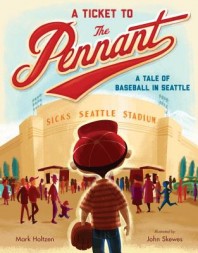 Every true fan knows, however, that the Golden Age of Baseball is whenever you’re nine years old. That’s when you’re old enough to understand the sport but young enough to love it unconditionally. Every adult should try to watch a game through those eyes at least occasionally. That’s why my most-anticipated baseball book of the season is A Ticket to the Pennant, written by Seattle’s own Mark Holtzen. In just 32 pages he tells the tale of Huey, a ’50s kid who wants nothing more than to get into Sicks Stadium and cheer for his hometown Rainiers. All he needs to do to make it through the turnstiles is find his missing ticket. Thus starts a search through the vibrant, diverse neighborhood around the park, a place brought to life by the uncannily accurate nouveau-retro illustrations of John Skewes, creator of Larry Gets Lost.
Every true fan knows, however, that the Golden Age of Baseball is whenever you’re nine years old. That’s when you’re old enough to understand the sport but young enough to love it unconditionally. Every adult should try to watch a game through those eyes at least occasionally. That’s why my most-anticipated baseball book of the season is A Ticket to the Pennant, written by Seattle’s own Mark Holtzen. In just 32 pages he tells the tale of Huey, a ’50s kid who wants nothing more than to get into Sicks Stadium and cheer for his hometown Rainiers. All he needs to do to make it through the turnstiles is find his missing ticket. Thus starts a search through the vibrant, diverse neighborhood around the park, a place brought to life by the uncannily accurate nouveau-retro illustrations of John Skewes, creator of Larry Gets Lost.
This is a book for young sports fans, obviously, but also for readers of any age who crave a sense of history and community. I’ll be reading it to my kids often at bedtime and probably on my own later in the evenings during the seventh-inning stretch. I think it’ll seem fresh and new every spring for years to come, like baseball itself.
James Crossley is a bookseller and blogger at Island Books on Mercer Island. He was there when A.J. Zapp became the first person to homer over the 29-foot wall that sits 425′ from home plate in Cheney Stadium, which was quite a thing to see.

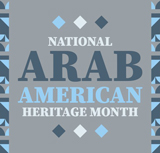
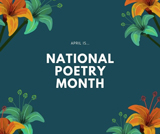
Pow! Or should I say “Thwack!!”? Since our too infrequent opportunities to converse at length usually center around movies, other kinds of books, and our children, I often forget your staggering baseball acumen. You’ve pulled me in, as usual, with a tantalizing round-up wrapped in a well-spun anecdote. Whenever I’m drawn to a sport like baseball it’s through the lens of a friend’s excitement about it.
True expert knowledge is like an iceberg, with the unseen part much more significant than the little bit that floats above the water. My baseball acumen is the opposite of that, more like the building facades they use on film sets. I’m flattered that the flashy surface caught your eye, though.
Man, is it ever baseball weather in Eugene today! You’re getting me fired up, James.
Portland is the halfway point between us, right? We could meet in the middle for a Pickles game.
I love “professional-style” baseball! I’m in.
[…] can get a signed copy, visit MarkHoltzen.com and check out reviews of A Ticket to the Pennant on NW Book Lovers and Kirkus […]